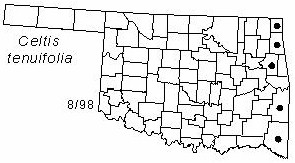Shrub or small tree to 6 m (20 ft) tall. Bark gray, smooth, with corky ridges. Twigs thin, gray, usually glabrous. Buds brown, blunt, sparsely hairy. Leaves alternate, broadly ovate, 2-7.5 cm (0.8-3 in) long and 1-4 cm (0.4-1.6 in) wide, sides unequal, margins usually entire, gray-green and usually smooth above, paler and glabrous to hairy below. Fruits on stalks at leaf bases, round, 6-8 mm (about 1/4 in) in diameter, dry, sweet, with 1 large seed, ripening in Fall.
Distribution: About the eastern third of the U. S. except for the northern border.
Habitat: Usually the understory of hardwood forests in rocky uplands.
NWI status: none
Comment: This species is variable and is sometimes difficult to distinguish from other species of Celtis The fruits are eaten by squirrels and many species of birds. Celtis is a name given by Pliny to some plant with sweet berries; tenuifolia refers to the thin leaves.
Distribution in Oklahoma: 
BACK
NEXT
RETURN TO INDEX
Last update: 9/9/99
 Go to Oklahoma Biological Survey Home Page
Go to Oklahoma Biological Survey Home Page
 Disclaimer
Disclaimer